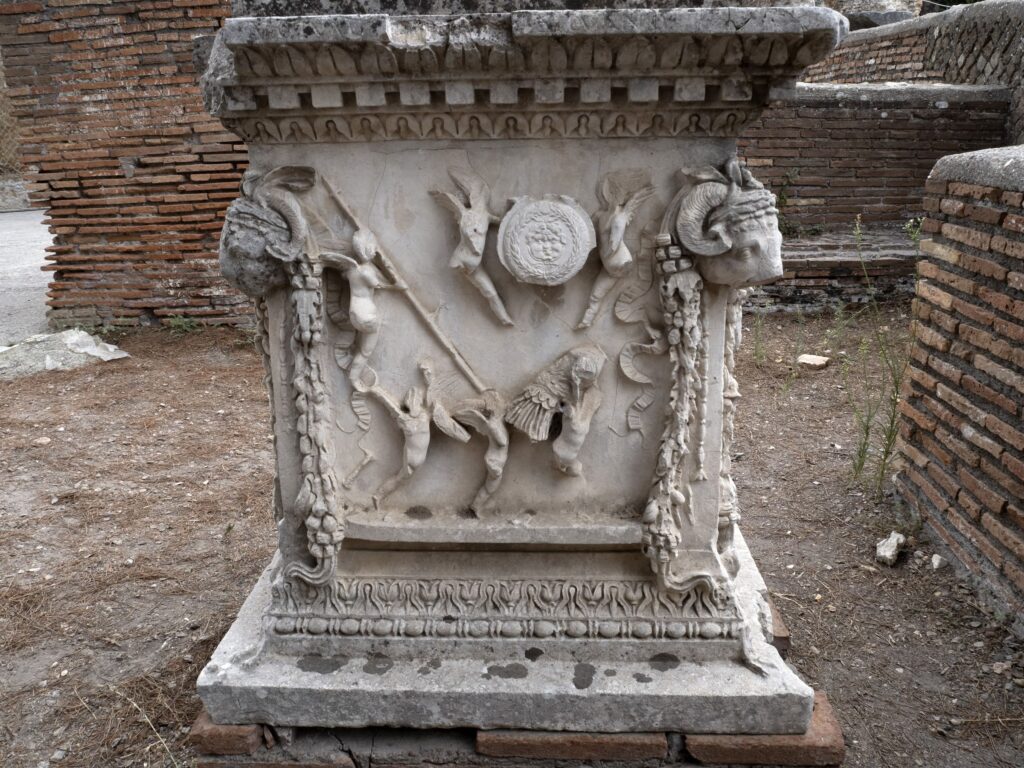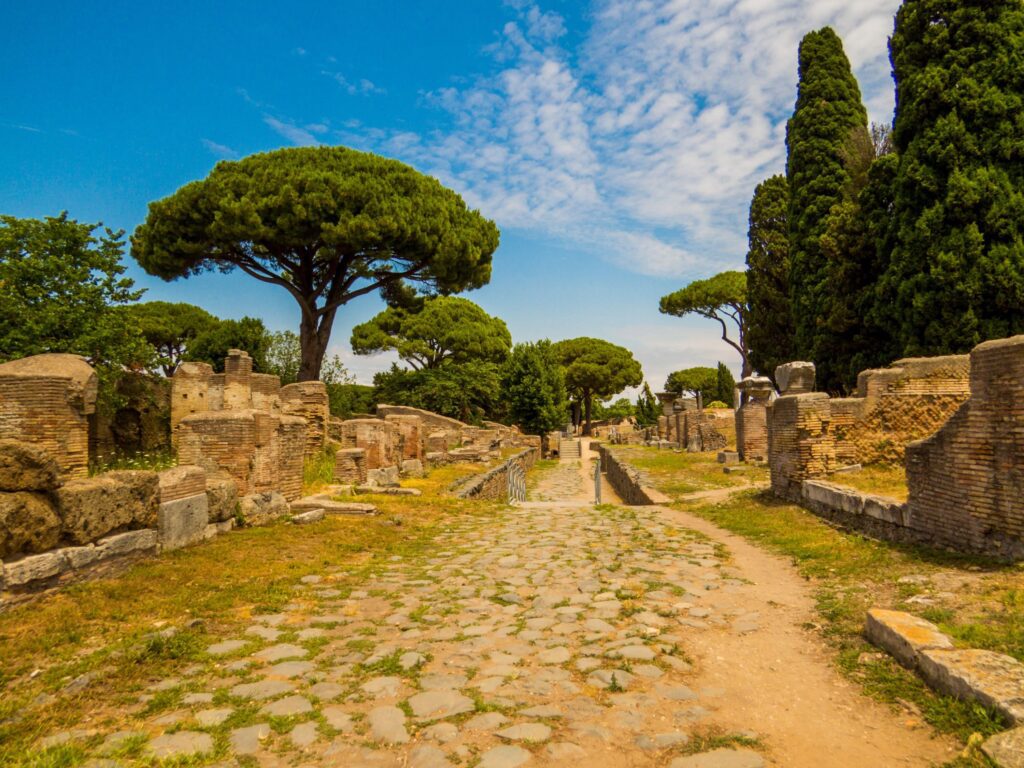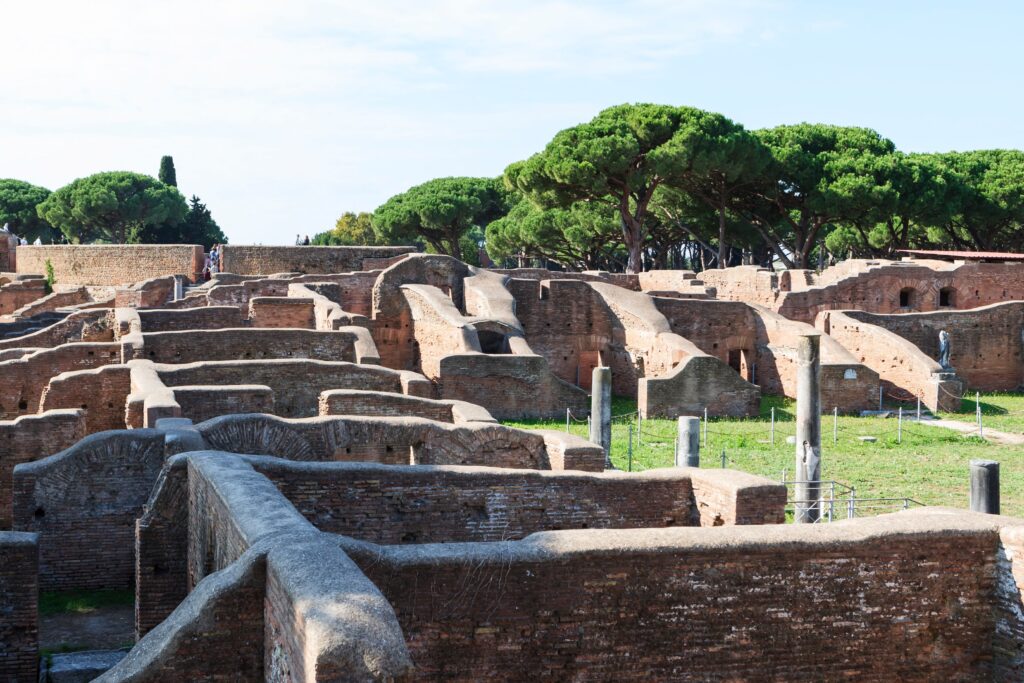Ostia Antica is a remarkable testament to Rome’s lost port city, once a bustling gateway for commerce and culture at the mouth of the Tiber River. This ancient Roman city played a crucial role in sustaining Rome’s growth, serving as its principal harbor for centuries. Ostia was not just a port; it was a vibrant urban center where trade, daily life, and religious practices intertwined.
Understanding Ostia Antica offers unique insights into the economic and social fabric of ancient Rome. Its ruins reveal streets, theatres, baths, temples, and homes that paint a vivid picture of Roman urban life far beyond the grandeur of Rome itself. The theatres found in Ostia serve as a reminder of the entertainment that was an integral part of Roman society, influencing social relationships and political authority.
Moreover, the agriculture that thrived in the region played a crucial role in Rome’s economic and social development. This sector extended beyond mere food production, influencing various aspects of daily life and economic stability.
The archaeological discoveries in Ostia not only bring this ancient metropolis back to life but also provide insights into Roman law, such as the significant milestone represented by the Twelve Tables which were the first attempt to codify complex legal practices.
This article invites you on A Visual Journey Through Ostia Antica: Rome’s Lost Port City — exploring these archaeological discoveries through detailed descriptions and imagery. You will uncover why Ostia remains essential for anyone interested in Roman history and its profound impact on Western civilization. Additionally, we will delve into some of the incredible engineering feats that have shaped our modern infrastructure systems.

Historical Background of Ostia Antica
Ostia Antica was founded in the 7th century BC as one of the earliest Roman settlements strategically located at the mouth of the Tiber River. This site was crucial, serving as a natural gateway for Rome’s maritime activities and trade. The establishment of Ostia was primarily motivated by military needs, aimed at safeguarding Rome from sea-based threats and controlling access to the river. This military strategy can be linked to the broader context of how figures like Scipio Africanus changed the course of history, establishing Rome’s dominance over Carthage during the Second Punic War.
Early History of Ostia
Key aspects of Ostia’s early history include:
- Established as a military naval base, it housed fleets that secured Rome’s interests along the coast.
- Its position at the Tiber’s mouth made it an ideal point for monitoring and managing river traffic.
- As Rome expanded, Ostia evolved beyond its military purpose into a bustling commercial port, facilitating the arrival of goods—especially grain—that sustained the growing population of the capital.
During its peak, Ostia became Rome’s principal port, vital in connecting the Mediterranean trade networks with the city. This evolution from a defensive outpost to a thriving economic hub reflects broader changes in Roman urban and imperial development. The port not only handled imports but also became a center where merchants, sailors, and diverse populations converged, shaping Ostia into a cosmopolitan locale integral to Roman port history.
Broader Implications
The story of Rome is not merely one of conquest and expansion; it is also a tale of innovation, culture, and governance that has left an indelible mark on the world. This narrative includes significant philosophical shifts such as the rise of Stoicism in Rome, which influenced important thinkers throughout the empire. Furthermore, understanding the birth of the Roman Republic provides essential insights into the complexities of Roman governance and its enduring impact on modern political structures.
In addition to these historical aspects, art and culture in ancient Rome played a significant role in shaping its identity. Ancient Roman art is a testament to the ingenuity and creativity of a civilization that thrived from 753 BC to 476 AD, marked by remarkable artistic expressions heavily influenced by earlier Greek and Etruscan traditions.

Architectural Highlights of Ostia Antica
Ostia Antica showcases remarkable architectural feats that reveal much about Roman urban planning and social life. The Roman theatre Ostia stands out as a centerpiece, built in the 1st century BC with seating capacity for around 4,000 spectators. Its semicircular design and tiered rows offered an impressive venue for theatrical performances and public gatherings, reflecting the cultural vitality of the city.
Public Baths: A Hub of Social Activity
Public baths were central to daily life in Ostia. The Baths of Neptune are particularly notable for their intricate mosaics depicting Neptune, sea creatures, and mythological scenes. These mosaics not only decorated the floors but also illustrated the Romans’ appreciation for art and leisure combined with hygiene. Other bath complexes in the city further underline the importance of communal bathing as a social ritual.
Temples: Expressions of Religious Devotion
Temples dedicated to major Roman deities stand prominently within Ostia’s sacred landscape. Temples honoring Jupiter, Juno, Minerva, and Hercules emphasize the religious diversity and devotion found here. Each temple exhibits classic Roman architectural elements such as columns, porticos, and altars designed to accommodate worshippers and ritual ceremonies.
These architectural highlights form a vivid tableau of Ostia’s public life—where entertainment, relaxation, and spirituality intersected within a thriving ancient port city. This vibrant urban environment was not merely a backdrop for daily activities; it was also shaped by broader socio-political dynamics reflected in aspects like the legal status of Roman women, which influenced gender roles within society.
The city’s strategic importance as a port also underscores the role of Roman roads in maintaining trade routes and military logistics. Such infrastructure was essential for the Roman army, whose might was instrumental in both the expansion and maintenance of the vast empire.
Moreover, these architectural marvels are not just mere structures; they represent masterpieces of ancient engineering, showcasing the innovative spirit of Roman builders who transformed their architectural landscape into a powerful symbol of cultural identity and dominance.

Residential and Commercial Structures in Ostia Antica
Ostia Antica’s urban fabric reveals a bustling daily life through its insulae apartments, multi-storied blocks that housed a large portion of the city’s population. These residential buildings varied in size and comfort, reflecting social hierarchies. Many insulae featured shops on the ground floors with living quarters above, creating a seamless blend of domestic space and commerce.
The presence of bakeries in Ostia highlights the importance of food production and distribution in this port city. Remains of ancient ovens and milling equipment provide insight into how bread—a staple for Romans—was produced on-site. Adjacent to bakeries, small shops sold goods ranging from pottery to textiles, revealing a lively local economy.
Ancient Ostia also housed brothels, identifiable by frescoes and inscriptions, which speak to the social dynamics and recreational activities within the city. Taverns and inns dotted the streets, serving as gathering places for sailors, merchants, and residents alike. These establishments not only offered food and drink but also functioned as social hubs where news and goods were exchanged.
- Insulae apartments: Varied sizes with commercial spaces below
- Bakeries: Equipped with ovens and mills for bread-making
- Shops: Selling everyday items like pottery, oil, wine
- Taverns and brothels: Reflecting social interaction and leisure activities
Exploring these structures during A Visual Journey Through Ostia Antica: Rome’s Lost Port City offers a vivid snapshot of urban life beyond monumental architecture. The combination of homes, businesses, and entertainment venues illustrates how commerce and community thrived side-by-side in this ancient port city.
Religious Sites in Ostia Antica
Ostia Antica offers a fascinating look into the religious diversity of ancient Rome through its well-preserved sacred sites.
Mithraea Temples: Worshipping the God Mithras
Among these sites, the city is notable for housing 18 Mithraea temples, small underground sanctuaries dedicated to the god Mithras. These Mithraea temples reflect the popularity of [Roman pagan worship](https://www.menofpompeii.com/exploring-the-ancient-roman-religion) focused on mystery cults that offered initiates secret rites and spiritual salvation. The architectural layout of these temples often includes a central aisle flanked by benches where worshippers gathered for ceremonies symbolizing cosmic dualities such as light and darkness.
The Oldest Synagogue in Europe: A Testament to Jewish Presence
In addition to the Mithraea, Ostia boasts an extraordinary religious landmark: the oldest known synagogue in Europe. This synagogue highlights the presence of a Jewish community within the cosmopolitan fabric of Ostia. Its existence illustrates the city’s role as a melting pot where various cultures and faiths coexisted. Archaeological findings inside the synagogue reveal inscriptions and frescoes that shed light on Jewish religious practices during Roman times, making it a critical piece of evidence for understanding early Judaism in Europe.
The coexistence of these religious sites—the pagan Mithraea alongside one of Europe’s earliest synagogues—demonstrates Ostia Antica’s complex spiritual landscape. It offers visitors insight into how religion shaped daily life, social identity, and community cohesion within this bustling ancient port city.
Decline and Transformation Over Time: The Fall of Ostia Antica
The decline of Ostia Antica was caused by a combination of outside threats and changing economic factors. One major event was the pirate attacks of 68 BC, which had a severe impact on the city. These attacks disrupted trade routes and exposed weaknesses in Ostia’s coastal defenses, leading to a decline in its security and commerce.
Competition from Rival Ports
Another factor contributing to Ostia’s decline was competition from other ports. Emperors Claudius and Trajan made investments in new harbor facilities in different locations, which resulted in maritime traffic being redirected away from Ostia. As a result, the flow of goods into the city decreased, and its commercial activity suffered.
Environmental Changes
Environmental changes also played a role in Ostia’s transformation. Over time, the mouth of the Tiber River gradually became silted up, causing the coastline to shift further outwards. This meant that Ostia was becoming more inland and less accessible to ships, which further worsened its economic situation.
Despite these difficulties, people continued to live in Ostia for many centuries. The city underwent a gradual evolution from being a bustling port to becoming a quieter provincial town before it was ultimately abandoned.
Excavations and Modern Discoveries at Ostia Antica Today – A Visual Journey
The Mussolini excavations Ostia Antica between 1939 and 1942 marked a pivotal moment in unearthing Rome’s lost port city. These large-scale archaeological campaigns aimed to reveal the grandeur of Ostia, showcasing the city’s significance beyond mere ruins. Work during this period exposed extensive street networks, public buildings, and residential quarters, allowing visitors today to walk through the ancient urban landscape almost intact.
Excavators uncovered detailed streetscapes that provide a window into daily Roman life. You can see well-preserved apartment blocks (insulae) where thousands lived, bakeries with ovens still visible, and shops displaying counters that once sold goods. Public spaces such as forums and temples emerged from beneath layers of earth, displaying intricate mosaics and architectural elements that highlight religious practices and community gatherings.
These findings have transformed Ostia from forgotten ruins into one of the most informative and immersive archaeological sites near Rome. The efforts from the Mussolini era laid foundations for ongoing preservation and study that continue to enrich our understanding of Roman urban life.
To truly grasp the essence of these discoveries, it’s essential to delve deeper into the broader context of daily life in ancient Rome, which was vastly different for various social classes. The plebeians, for instance, represented the common people of ancient Rome who were vital to the fabric of society. Their daily activities, traditions, and ways of living varied greatly from those of the patricians or elite class.
Moreover, understanding these archaeological findings also sheds light on the enduring influence of Roman law on modern legal systems. The principles established during this time are still relevant in various legal systems today. This legacy is further exemplified by the [Corpus Juris Civilis](https://www.menofpompeii.com/the-enduring-influence-of-the-corpus-juris-civilis-on-modern-law), a significant achievement in the history of law commissioned by Emperor Justinian I in the 6th century AD.
Overall, exploring Ostia Antica provides more than just a glimpse into an ancient metropolis frozen in time; it offers valuable insights into the social dynamics, legal foundations, and daily life of one of history’s greatest civilizations.
Experiencing Ostia Antica Today – A Visual Journey Through Time
Visiting the Ostia Antica ruins offers a unique opportunity to walk through a remarkably preserved Roman archaeological site. The layout of the ancient city remains visible in its cobbled streets, inviting you to explore the urban fabric of Rome’s lost port city.
You can wander through several key highlights:
- Ancient streets lined with remnants of shops, taverns, and apartments (insulae), giving a real sense of daily life.
- The Roman theatre, still imposing with its semi-circular seating, evokes the entertainment culture of antiquity.
- Public baths, especially the Baths of Neptune, showcase intricate mosaics and sophisticated engineering.
- Various temples dedicated to deities like Jupiter and Hercules provide insight into religious practices that have influenced modern culture significantly.
The experience differs from Pompeii’s more famous excavation by offering a less crowded environment. This tranquility allows for thoughtful reflection on the scale and complexity of Roman urban planning without overwhelming tourist traffic. Unlike Pompeii’s sudden volcanic preservation, Ostia reveals gradual historical layers shaped by commerce and time.
Roman archaeological site tourism at Ostia Antica combines immersive exploration with educational opportunities, making it a compelling destination for those interested in Rome’s imperial past beyond its capital. Walking among these ruins connects you with centuries-old stories etched into stone and mortar. The remnants of ancient streets lined with shops and taverns offer a glimpse into daily life in Rome, while the imposing Roman theatre evokes the entertainment culture of antiquity.
Conclusion
Visiting Ostia Antica offers an immersive historical journey that brings you face-to-face with the significance Ostia Antica today holds as a window into ancient Roman life. Walking its cobbled streets and exploring its theatres, baths, temples, and marketplaces allows you to step back in time and experience Rome’s lost port city firsthand.
Preserving Roman heritage at Ostia Antica remains a vital effort. Continuous archaeological work and conservation projects protect this remarkable site from natural decay and human impact. These initiatives ensure future generations can appreciate the rich tapestry of commerce, religion, and daily living that defined Ostia.
You owe it to yourself to embark on A Visual Journey Through Ostia Antica: Rome’s Lost Port City — a destination offering authenticity, history, and preservation combined in one extraordinary archaeological treasure.
FAQs (Frequently Asked Questions)
What is Ostia Antica and why is it significant in Roman history?
Ostia Antica was Rome’s ancient port city founded around the 7th century BC at the mouth of the Tiber River. It served as Rome’s principal port, evolving from a military naval base into a bustling commercial hub, playing a crucial role in the economic and social life of ancient Rome.
What are some key architectural highlights of Ostia Antica?
Ostia Antica boasts impressive architectural features including a large Roman theatre with a capacity for 4,000 spectators, the Baths of Neptune adorned with intricate mosaics, and temples dedicated to deities such as Jupiter, Juno, Minerva, and Hercules, reflecting its rich cultural heritage.
What types of residential and commercial structures can be found in Ostia Antica?
The site includes insulae apartment blocks that housed residents, bakeries and brothels indicative of daily commerce and social life, as well as various shops and taverns that showcase the local economy during ancient times.
What religious sites exist in Ostia Antica demonstrating its religious diversity?
Ostia Antica contains 18 Mithraea representing pagan religious practices, as well as the oldest known synagogue in Europe, illustrating the diverse religious landscape including Roman pagan worship and early Jewish communities.
What factors contributed to the decline of Ostia Antica?
The decline of Ostia Antica was influenced by several factors including pirate attacks around 68 BC and increasing competition from rival ports, which diminished its strategic and commercial importance over time.
How can visitors experience Ostia Antica today?
Today, visitors can explore the extensive archaeological park featuring ancient streetscapes, theatres, baths, temples, and residential areas. Ostia offers a less crowded but equally rich historical experience compared to sites like Pompeii, allowing an immersive journey through Rome’s lost port city.

